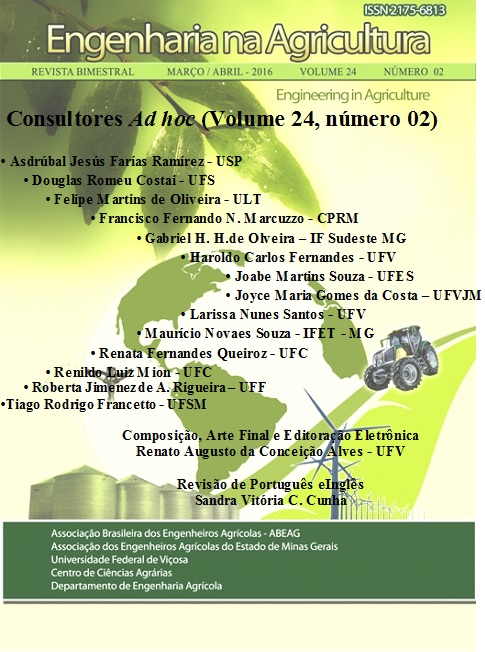PRODUCTION AND TILLERING OF MOMBAÇA GRASS WITH DIFFERENT SOURCES AND LEVELS OF APPLIED NITROGEN
DOI:
https://doi.org/10.13083/reveng.v24i2.664Palavras-chave:
dry matter, fertilizers, Panicum maximumResumo
Nitrogen influences numerous physiological and morphological traits of forage grasses, which ultimately interfere directly with production and forage quality. Aimed to study was to evaluate the production of dry matter and the number of tillers of Panicum maximum cv. Mombaça grown with different sources and levels of applied nitrogen. The experiment was conducted at the Federal Institute of the Espírito Santo, Campus of Santa Teresa. The experimental design consisted of a randomised block design with three replicates in a 3 x 6 factorial design and three nitrogenous fertilizers (urea, ammonium sulphate and calcium nitrate), which were applied at six different levels (0, 120, 240, 360, 480 and 600 kg ha-1) during the experimental period, for a total of 54 experimental units. Nitrogen levels were divided into seven applications, and the treatments were applied every 28 days, always after the forage was cut. The results show that Mombaça grass is responsive to nitrogen fertilization, and the response in terms of dry matter production and number of tillers for the same level of nitrogen varies depending on the nitrogen source used. Of the nitrogen sources, calcium nitrate had the best performance for the variables evaluated here. For this nitrogen source, the production of dry matter achieved at the maximum level of nitrogen was 18% and 36% higher than the dry matter achieved with the use of ammonium sulphate and urea, respectively.Downloads
Downloads
Publicado
Como Citar
Edição
Seção
Licença
Autores que publicam nesta revista concordam com os seguintes termos:
O(s) autor(es) autoriza(m) a publicação do texto na da revista;
O(s) autor(es) garantem que a contribuição é original e inédita e que não está em processo de avaliação em outra(s) revista(s);
A revista não se responsabiliza pelas opiniões, ideias e conceitos emitidos nos textos, por serem de inteira responsabilidade de seu(s) autor(es);
É reservado aos editores o direito de proceder a ajustes textuais e de adequação às normas da publicação.
A partir da submissão, o autor estará cedendo integralmente seus direitos patrimoniais da obra à publicação, permanecendo detentor de seus direitos morais (autoria e identificação na obra) e de acordo com a Licença Creative Commons, CC BY-NC.








 Esta obra está licenciada com uma Licença
Esta obra está licenciada com uma Licença 